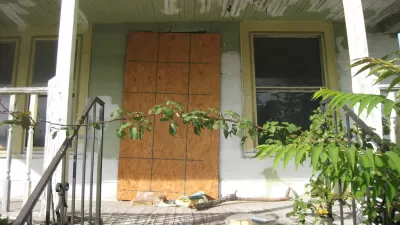With roughly 10,000 foreclosures in the last two years, Cleveland has been hit hard by the economic crisis.
"Vacant houses are not a new phenomenon to the city. Ravaged by the closing of American steel mills, Cleveland has long been in decline. With fewer manufacturing jobs to attract workers, it has lost half its population since 1960. Its poverty rate is one of the highest in the nation. But in all those years, nothing has approached the current scale of ruin.
And in December, just when local officials thought things couldn't get worse, Cuyahoga County, which includes Cleveland, posted a record number of foreclosure filings. The number of empty houses is so staggeringly high that no one has an accurate count. The city estimates that 10,000 houses, or 1 in 13, are vacant. The county treasurer says it's more likely 15,000. Most of the vacant houses are owned by lenders who foreclosed on the properties and by the wholesalers who are now sweeping in to pick up houses in bulk, as if they were trading in baseball cards."
FULL STORY: All Boarded Up

Trump Administration Could Effectively End Housing Voucher Program
Federal officials are eyeing major cuts to the Section 8 program that helps millions of low-income households pay rent.

Planetizen Federal Action Tracker
A weekly monitor of how Trump’s orders and actions are impacting planners and planning in America.

Ken Jennings Launches Transit Web Series
The Jeopardy champ wants you to ride public transit.

Crime Continues to Drop on Philly, San Francisco Transit Systems
SEPTA and BART both saw significant declines in violent crime in the first quarter of 2025.

How South LA Green Spaces Power Community Health and Hope
Green spaces like South L.A. Wetlands Park are helping South Los Angeles residents promote healthy lifestyles, build community, and advocate for improvements that reflect local needs in historically underserved neighborhoods.

Sacramento Plans ‘Quick-Build’ Road Safety Projects
The city wants to accelerate small-scale safety improvements that use low-cost equipment to make an impact at dangerous intersections.
Urban Design for Planners 1: Software Tools
This six-course series explores essential urban design concepts using open source software and equips planners with the tools they need to participate fully in the urban design process.
Planning for Universal Design
Learn the tools for implementing Universal Design in planning regulations.
Heyer Gruel & Associates PA
Ada County Highway District
Institute for Housing and Urban Development Studies (IHS)
City of Grandview
Harvard GSD Executive Education
Toledo-Lucas County Plan Commissions
Salt Lake City
NYU Wagner Graduate School of Public Service




























